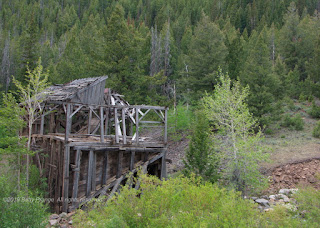 |
| Museum in the old general store in Clayton, ID |
Like California, Idaho has a rich history of mining. Gold, silver, lead and other minerals played a role in exploration and early settlement of parts of the State. On earlier trips to the area I explored Silver City in the very southwest corner. My first magazine article, with photos Lin and I took, was of that ghost town.
This summer I am exploring areas around Stanley. Custer and Bay Horse, are state parks and are being maintained. Other areas are on national forest lands and are just a few ruins of buildings. I've included photos of some of these explorations for readers to see.
BAY HORSE, IDAHO
Located southwest of Challis, this town got its start as a gold mining town in 1877. The mine there failed but silver deposits kept the town thriving, for a while. Like so many old mining towns, fires, weather, vandalism and time have taken a toll. But this community still has a number of standing buildings, although they are not safe to enter. Walkways with fences allow visitors of see the old stamp mill and a variety of buildings from the exterior.
 |
| State Park employee putting new roof on old building. |
 |
| Kilns to make charcoal to fuel the mill |
Following three photos were taken outside the main part of town but in the same general vicinity.
CUSTER CITY
Custer City is located along the Yankee Fork, closer to Stanley. Also a state park, some of the buildings may be entered and artifacts of the day are displayed.
 |
| This equipment came from the stamp mill where ore was crushed. This held 5 stamps, which dropped in a rotating pattern to crush the ore from which gold and silver could be extracted. |
YANKEE FORK DREDGE AND BONANZA
 |
| Several old buildings remain in the community of Bonanza. near the Yankee Fork Dredge. |
 |
This dredge operated until the 1950s, except for closure during WWII, along the Yankee Fork which in turn feeds into the
Salmon River. It worked its way along the river, scooping up and depositing huge piles of rocks. Some mitigation efforts are underway now to restore the river to its pre-mining days. My guide was a man who grew up in Bonanza, his father worked on the dredge and adjacent mining areas. |
CLAYTON
Clayton, population 7, is on hwy 75, north east of Stanley. But it has a great museum, open only on weekends. Co-worker Christina and I went to breakfast at the cafe in Sunbeam for their last day of the season and then continued on to Clayton, before returning for 2 pm start of work. Photo inside the museum is at the top of the page
 |
| Old store is now a museum |
 |
| Clayton. |
GENERAL PHOTOS OF MINING AND EARLY RANCHING
 |
Old mining camps always have plenty of trash from another era. I hate modern litter but somehow find the
discards of a previous time an indication of how lives were led. |
 |
| Soon after my arrival in Stanley I took a tour with the local historical society on the "Nip and Tuck" road out of town. Numerous remains of cabins are found along the route. |
 |
| Another cabin on the tour of the Nip and Tuck Road outside Stanley |
 |
| Across from the road to Stanley Lake. |




































No comments:
Post a Comment